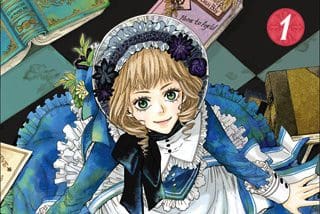Lizzie Newton is equal parts Agatha Christie and Sherlock Holmes, a budding mystery writer who does more than write mysteries—She solves them, too. No one wants to believe this of her, though, because this is the Victorian era, after all, and women don’t do that sort of thing. This is why Lizzie must hide her talents behind a masculine pen name and send her deductions through her lawyer-in-training fiancé, Edwin. But this doesn’t stop her from traipsing onto crime scenes as she sees fit, prodding corpses, and showing up everyone who thinks she’s wrong with a cute grin and the power of logic and science.
 I didn’t expect much of Hey-jin Jeon’s Lizzie Newton: Victorian Mysteries Volume 1 simply because I’d never heard of it before. Now that I’ve finished it, I can’t help but wonder why. It’s a true gem of a comic.
I didn’t expect much of Hey-jin Jeon’s Lizzie Newton: Victorian Mysteries Volume 1 simply because I’d never heard of it before. Now that I’ve finished it, I can’t help but wonder why. It’s a true gem of a comic.
What’s most impressive about Lizzie Newton is the number of things that could have gone wrong in the comic compared to the number of things that it did very well. The illustration on the cover—wide-eyed Lizzie, smiling sweetly in a frilly dress—led me to expect the adventures of a vapid girly-girl who stumbles clumsily but adorably into her solutions because that’s what happens in manga where the protagonist is a cute girl. Lizzie is anything but. While she is absent-minded, it’s in an intellectual way—She’s so distracted by the thrill of solving a mystery that it never occurs to her that it is NOT OK to poke her finger into the bullet hole in a corpse’s head before the police even arrive to investigate the scene. And though she is, for all appearances, a cute Victorian lady with limited practical sense, there’s a real brain behind that bonnet, and a personal collection of books and scientific equipment to back it up. She’s a perfect combination of “feminine” cuteness and “masculine” logic, without being an exaggeration of either. Her relationship with Edwin is also refreshingly positive. Edwin himself is a capable (as opposed to amusingly bumbling) companion. Though he does, of course, become exasperated with Lizzie’s absent-mindedness, he’s ultimately supportive of her investigative hobbies and does what he can to make Lizzie’s discoveries known—in her name. In fact, in addition to portraying a female protagonist who is productively interested in science (as opposed to using science for comedic, explosive effect), the comic makes a notable effort to say, “You know that famous male scientist who discovered that thing? Yeah, half of that work was done by an un-credited woman” (in this face, Ada Lovelace, who wrote the language for the Analytical Engine that preceded Charles Babbage’s unfinished Difference Engine). Yet none of these feministic elements are ever preachy. Lizzie Newton is definitely a Girl Power/Girl-Who-is-GASP-Interested-In-Science book, but it’s more interested in its amusing characters and the details of its plot to dwell on the social concerns that it brings up.
Plot-wise, it’s an interesting whodunit, though the process Lizzie follows to solve the mystery is more interesting than the mystery itself. I never really cared about who may or may not have killed whom in the story, but that was mostly because 1) they were background characters anyway, and 2) the rest of the comic is more interesting.
The art in the book is also worth a mention. The detail that artist Ki-ha Lee puts into costumes and settings is reminiscent of Yana Toboso’s Black Butler, as is the occasional tonal shift between dark, dramatic illustration and funny chibis. In fact, I’d go as far to say that this manga is what Black Butler would be if it involved a detective and an actual point. Tonally, the two are almost identical (even if their stories are ABSOLUTELY dissimilar). The care put into the artwork also recalls Kaoru Mori’s Emma, which was noted for its artist’s obsessive interest in Victorian details, even if her character designs were a bit blah. Lee’s designs lean more toward Toboso’s distinct, expressive characters. Either way, the artwork is lovely and enough reason, on its own, to read the book.
Lizzie Newton: Victorian Mysteries, then, is an excellent manga for readers who enjoy a good mystery with wonderful art, a dash of scientific investigation, and a sneaky lot of girl power spunk. (Note: The back of the book claims that it also contains “a spot of Jane Austen,” which it doesn’t, unless you count the fact that Lizzie shares a name with one of Austen’s protagonists. Also Jane Austen was Regency, not Victorian, so GET YOUR LITERARY PERIODS STRAIGHT, MARKETERS. Anyway, regardless, Austenites are likely to enjoy it because frilly dresses and pride-and-prejudice-smackdowns and stuff.)

Leave a Reply